-
Car Reviews
- All reviews
- Midsize SUVs
- Small cars
- Utes
- Small SUVs
- Large SUVs
- Large cars
- Sports SUVs
- Sports cars
- Vans
Latest reviews
- Car News
-
Car Comparisons
Latest comparisons
- Chasing Deals
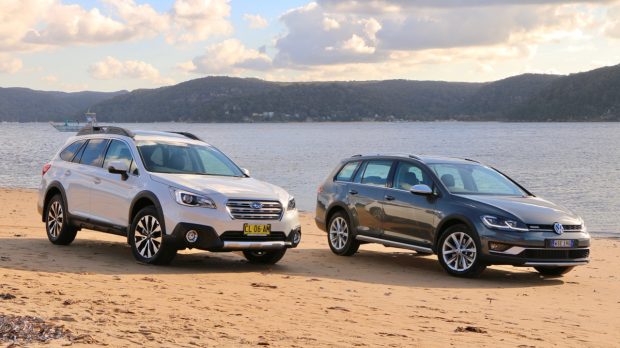
If you need a family car and you’ve got between $40,000 and $50,000 to spend, you’re spoiled for choice. Everything from large hatches and small sedans, station wagons, to medium and even seven-seater SUVs are on the table in this hot price range – but the skew of purchases is far from even. The average Australian in this space buys a midsize SUV. But while they offer a high driving position, SUVs have their compromises. They’re usually thirstier and less fun to drive than their traditional equivalent – the wagon. Thankfully, for the thinking family car buyer, there are some great wagons – even ones equipped with all-wheel-drive and rugged body cladding – that offer an alternative to a high-riding SUV. We love wagons, and here, we look at two of the best for under $50,000: the Subaru Outback Premium 2.0D vs the Volkswagen Golf Alltrack Premium 135TDI.
These smart family wagons actually offer the best of both worlds. Both the Outback and Golf Alltrack have more ground clearance than a normal wagon – 221mm and 175mm respectively – so you can take them a little bit off-road, and they have a higher driving position than a normal car, especially in the case of the Subaru. However, their low, station wagon lines outside mean they look like a regular car. The Alltrack and Outback take up less room on the road, they’re easier to see around, and they have fewer blind spots. And these cars are affordable: the Golf Alltrack ranges from $34,490 to the $40,990 135TDI Premium tested here, while the Subaru Outback starts at a similar $35,740, but runs to a dearer $48,740 3.6R version with a flat six-cylinder engine. The 2.0D (diesel) Premium tested here is priced at $45,240.
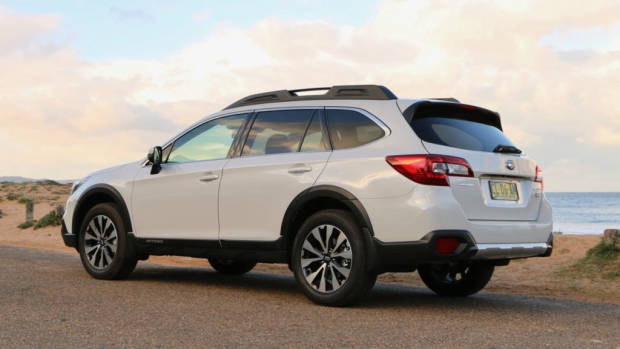
Raised, all-wheel-drive station wagons were actually the original family SUV. Subaru invented the formula in 1982 with the L-Series Touring, while the Outback as we know it arrived in Australia in 1996. Many readers will also remember the uber-popular Volvo XC70 Cross Country of the late 1990s and 2000s. Before SUVs arrived en masse, if you wanted the ability to get down a rocky firetrail, you bought a cladded wagon like an Outback, Cross Country, or something posh like an Audi Allroad.
These days, the high-set SUV is the far more popular choice – but the Subaru Outback in particular remains highly competitive in sales volume, despite the fact it is essentially a traditional wagon. In 2017, almost 12,000 Outbacks will have been sold in Australia – just shy of Subaru’s own SUV, the Forester, and roughly equivalent to the Toyota Kluger. While Subaru market the Outback as an SUV (“for Australiana”, no less), buyers know that it really isn’t – and one of the Outback’s most attractive features is its lower roofline and easier access. It’s a car, not a truck.
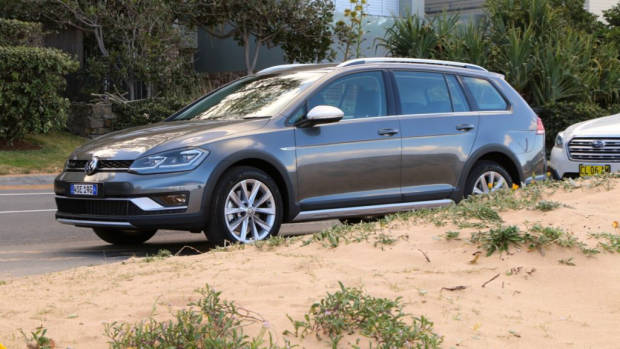
Volkswagen, on the other hand, offer two raised wagons, and some will wonder why we aren’t comparing the 4.8m-long Outback to the similarly-sized Volkswagen Passat Alltrack. The answer is that the Passat, which starts at $50,790, is priced well above the Subaru. While the Golf Alltrack is noticeably shorter than the Outback – at about 4.6m – it offers similar cargo capacity, and most critically for buyers, it is priced like the Subaru and is, ultimately, more likely to be cross-shopped. What the two Alltracks have in common is their relatively niche status: the Outback outsells both combined at a rate of about 7 to 1.
On paper, the Golf Alltrack and Outback offerings are pretty similar. But as is so often the case, the way the Golf Alltrack and Outback behave on – and off – the road in the real world is different, and each will suit a different buyer. So, let’s get into it.
Volkswagen Golf Alltrack
The Golf Alltrack can be had with a choice of two turbocharged engines: petrol or diesel. There’s a 132kW/280Nm 1.8-litre petrol called 132TSI that can be had in base model ($34,490) or more luxurious Premium form ($38,490). Meanwhile, the 135kW/380Nm 2.0-litre diesel, named 135TDI, is only available in the Premium trim ($40,990). Both engines are paired with a dual-clutch automatic gearbox. For those who are au fait with the Volkswagen DSG, the petrol has a dry-clutch box while the diesel has a high-torque wet clutch unit.
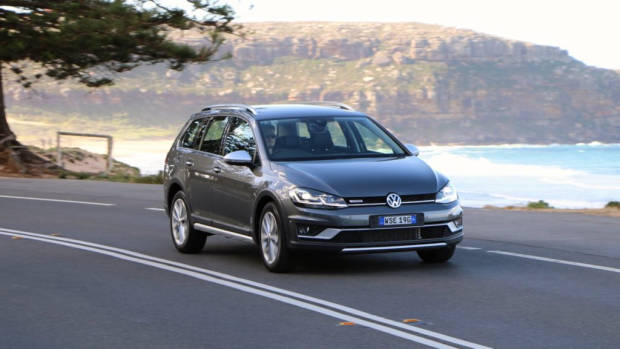
While the diesel has a slightly more refined transmission that exhibits less of the roll and hesitancy at low speeds that characterise dual-clutch automatics, the petrol is the pick of the engines. Not only is the petrol $2,500 cheaper, but it is faster, more refined, and more fun. We tested the diesel, which is louder and more agricultural than you’d expect. While the diesel offers good long-distance fuel economy of around 6L/100km, compared to about 7.5L/100km for the petrol, the buttery petrol is the nicer of the pair to live with every day.
Where the Golf Alltrack excels is in the handling department. It may sit about 33mm higher off the road than a standard Golf wagon, but you’re hard pressed to feel any difference. The driving position is ultimately carlike, and so are the Alltrack’s responses when being pushed down a mountain road. The steering is direct and moderately communicative, and the Golf’s MQB chassis remains peachy even in this longer vehicle, with a back end that will gladly push into controlled oversteer after a very fast corner entry. For skilled drivers, the Golf Alltrack offers many degrees of extra driving fun than the Subaru.
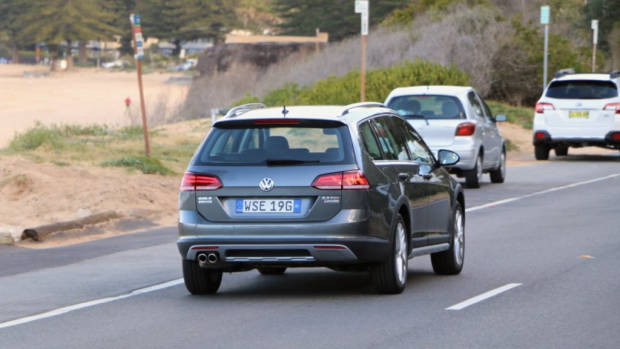
The trade-off is that the Golf has an almost sporty ride quality, which really means ‘firm’. You feel bumps and imperfections in the road in the Alltrack that you simply don’t in the Outback. It’s not uncomfortable, but nor is the Volkswagen a moving armchair. For drivers that like to engage with the car and the road, this will be a positive. Skip the diesel engine and it’s nice and quiet inside the Golf, with the exception of when you hit large potholes, which send a thump through the chassis.
Off road, the Golf Alltrack is mainly hindered by its limited ground clearance of 175mm, and its part-time 4MOTION all-wheel-drive system, which only kicks in when the car senses a loss of traction at the front wheels. That said, these cars will be driven on-road 99.9 (repeater) per cent of the time, and if you do need to venture down a moderate camping trail, the Golf Alltrack will most likely be sufficient.
Subaru Outback
You get a choice of three engines with the Subaru Outback: two petrols, and a diesel. First, to the petrols: most people by the Outback with the 2.5-litre naturally aspirated petrol, which produces 129kW/235Nm, and feels breathless when pushed. The 2.5i model is available in base model form ($36,240) or the Premium trim ($42,240). There is also a six-cylinder petrol called the 3.6R, which at $48,740 is the most expensive Outback – but it does produce potent 191kW/350Nm outputs. Both petrols are exclusively mated to a continuously variable automatic transmission.
But it’s the available turbodiesel – a 2.0-litre making 110kW/350Nm – that is the ideal engine for the Outback, adding easy grunt without the expense of the 3.6R. Plus, the extra weight of the diesel engine drastically improves the Subaru’s steering, adding more steering feel to a tiller that is way too light in the 2.5-litre petrol. The diesel can be had with a six-speed manual or the CVT automatic from the petrols, for an extra $3,000. The 2.0D is available as a base model ($35,740 / $38,740) or in the Premium grade ($42,490 / $45,240).
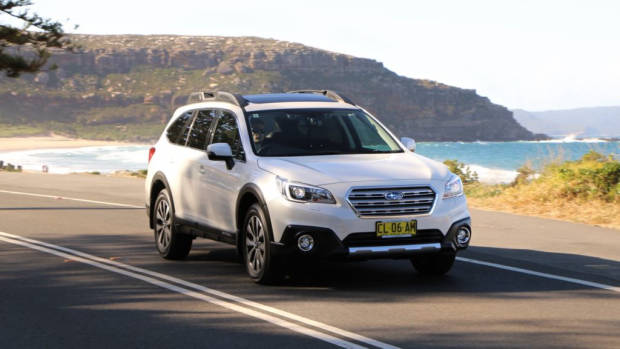
We tested the diesel with the CVT, which is a popular choice with buyers. The combination works well: where the CVT is restless with the torque-starved 2.5-litre petrol, with 350Nm to play with from the turbodiesel, the automatic has plenty of grunt to work with, and it keeps the revs low most of the time. This is a quiet diesel – much more hushed than the Volkswagen – so it’s a relaxing car to drive around town. It’s also very frugal on fuel, recording under 6L/100km in country driving.
The Outback’s big advantage is its ride quality, which is incredibly supple. Road imperfections and bumps are ironed out well, and the large, comfortable seats mean driving the Outback is akin to sitting in a plush armchair. Many drivers will love that, in direct contrast to the more sporty, feelsome Golf Alltrack.
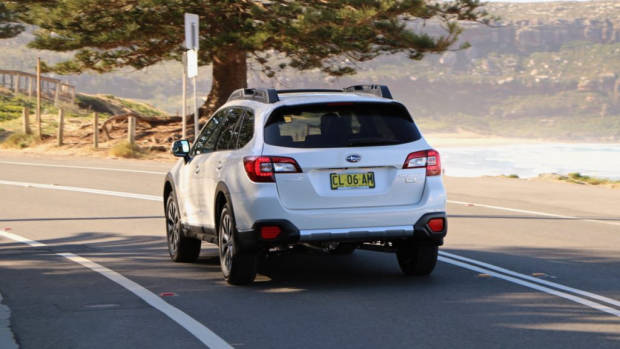
However, start pushing the Outback into corners and its weaknesses come to the fore. The Subaru is simply not set up for dynamic driving. There’s plenty of body roll, and, while the diesel has a lot more steering weight, there isn’t much correspondence from the front wheels to the driver. The Outback isn’t a car you want to drive fast and hard – it’s a relaxed cruiser.
Winner: Golf Alltrack. Part of the charm of a wagon-based family car is that they are more dynamic and fun to drive, which the Volkswagen delivers. That said, the Subaru Outback will impress those who want a bias towards comfort.
Both Volkswagen and Subaru offer plenty of choice within the Alltrack and Outback ranges. We’ve already reviewed the choice of engines – but how do these wagons compare in their respective base model and Premium trims?
The Golf Alltrack kicks off at an attractive $34,490 price point, for the 132TSI model. This vehicle packs a reasonable level of equipment, with keyless entry and start, 17-inch wheels with tyre pressure monitoring, dual-zone climate control, an 8-inch touchscreen with Apple CarPlay and Android Auto technology, eight speakers, a leather steering wheel and gear shifter, automatic lights and wipers, chrome roof rails, autonomous emergency braking, an off-road mode and seven airbags all featuring as standard.
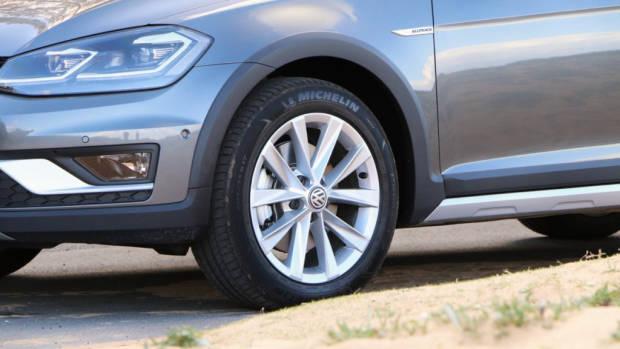
By comparison, the base model Outback, which starts at $35,740 (manual diesel), or $36,240 (auto 2.5-litre petrol), offers slightly lighter levels of standard equipment. It features 18-inch wheels (17-inch on the base diesel), automatic headlights, dual-zone climate control, cloth seats, X-Mode for off-roading, and heavier-duty black roof rails with integrated crossbars. The petrol model features Subaru’s EyeSight adaptive safety suite as standard – the base diesel does not. This package includes autonomous emergency braking, adaptive cruise control, and lane departure warning. The Subaru’s infotainment is inferior, with a 6.2-inch screen with no smartphone mirroring, and there are only six speakers.
Stepping up to the Premium grade makes a little difference in the Golf, and a big difference in the Outback.
For an extra $4,000, you step from the Golf Alltrack into an Alltrack Premium. The additional outlay adds LED headlights, satellite navigation, and leather seats that are heated in the front row.
Meanwhile, the Outback Premium costs an extra $6,000 over the standard Subaru. The Outback Premium not only adds all of the extras from the Alltrack Premium, but it goes further, adding niceties like six-way electrically-adjustable front seats, a sunroof, automatic high beam, and an electric tailgate. The Outback Premium also gains safety features in the form of blind spot monitoring and rear cross-traffic alert – two systems the Golf Alltrack does not offer at all.
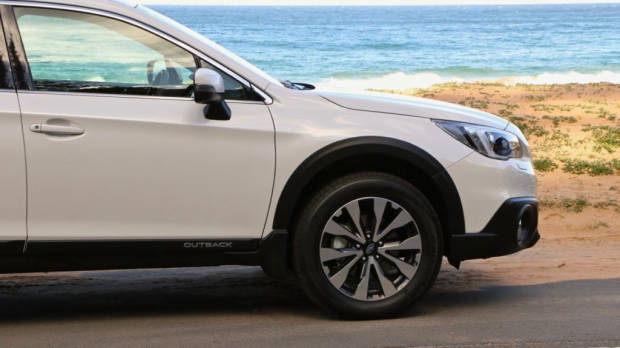
That said, the Golf Alltrack allows most of the Outback Premium’s standard kit to be added in via packages – and the Volkswagen hides even more sophisticated tech on the options list. That makes sense: our preferred Golf Alltrack, the 132TSI Premium, costs $38,490 before options; our preferred Outback, the 2.0D Premium automatic, is more costly, at $45,240 – a $6,750 difference that narrows to $4,250 if you choose the diesel-powered Golf Alltrack Premium.
And the VW’s list price advantage means you have room to add those options before you reach the Subaru’s loftier price. The Golf features three option packages: the $2,900 Sport Luxury package adds 18-inch wheels, electric seat adjustment for the driver, with 3-position memory, a panoramic sunroof, folding mirrors, and paddle shifters. The $1,300 Driver Assistance Package adds Volkswagen’s worthwhile Active Info Display, a 12-inch high-resolution screen that replaces the traditional analogue driver gauges. It also adds adaptive cruise control, lane keep assist, and automated parking. The $2,300 Infotainment Package also adds the Active Info Display, plus a crisp 9.2-inch touchscreen, and a 10-speaker, 400-watt premium Dynaudio stereo. Because of their overlap, the Infotainment and Driver Assistance packages can be combined for $3,400. Premium paint costs $500.
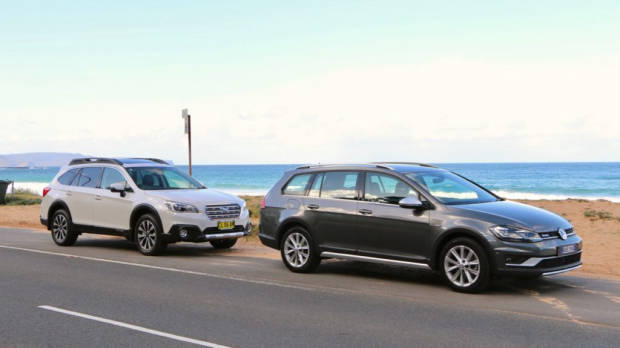
So, an Alltrack 132TSI Premium with the Driver Assistance, Infotainment and Sport Luxury packages, plus premium paint ($6,800 combined) comes in at $45,290 – $50 dearer than the Outback 2.0D Premium. Choose the Alltrack 135TDI (diesel) Premium, though, and this blows out to $47,790, which is a couple of grand more expensive than the Subaru. By the way, the Outback doesn’t have a single option available – even metallic paint is standard.
Winner: Outback. However, the margin is narrow. Our ideal Golf Alltrack (a fully-optioned 132TSI Premium) costs just $50 more than our ideal Outback, the 2.0D Premium.
Volkswagen Golf Alltrack
Near luxury-grade cabins at mainstream prices have been part of Volkswagen’s unique selling proposition for years – and the Golf Alltrack doesn’t let down the side. The Alltrack’s cabin is handsome, if conservative, and largely made of materials that feel premium enough to come from the class above. That’s the case on both the base model, with its quality cloth trim, or the Premium, which features Volkswagen’s soft, black, heated Vienna leather. The key touch points are sensory: there is creamy-soft leather on both the steering wheel and gear shift, and the dashboard is covered in soft, yielding plastic. Only scratchy, hard plastic where your leg rests against the centre console lets down the luxurious effect.
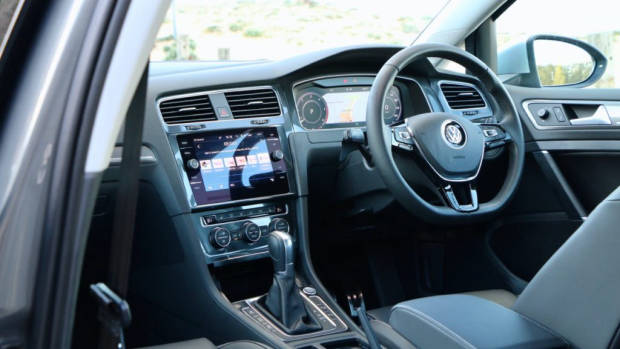
Aside from some Alltrack badging, the interior is entirely in common with the regular Golf wagon – a little more differentiation, such as unique stitching, would have elevated the experience a little further. After all, the Alltrack does start more than $6,000 above the entry price of a garden-variety Golf wagon.
Like all Golfs, the seats are comfortable and supportive, including over long distances. The shape is wide enough to support lots of body types, without feeling flat. The lack of standard electric adjustment on the Premium trim feels nickel-dimey, though; this feature is only available through the Sport Luxury package, and even then, it is only fitted to the driver’s seat; the Outback Premium has generous, standard electric adjustment on both seats. However, a good driving position is easy to achieve even with the manual seats.
Ergonomics are also a strong point, with logical controls falling easily to hand, especially with the (lower-end) 8-inch touchscreen which retains physical volume and tuning knobs. However, there is some evidence in the Alltrack, like other Volkswagens, of a lazy right hand drive conversion. The volume knob is on the passenger side, and the gear shift obscures controls that should be proximate to the driver, like the auto start-stop function, or the drive mode selection.
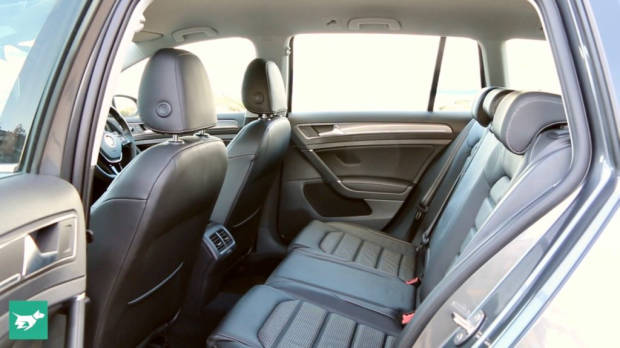
Volkswagen’s car technology is among the best at this price point. Both available touchscreens (with 8-inch, or 9.2-inch screens) are excellent, with easy-to-use software, and standard Apple CarPlay and Android Auto systems, though only the Premium gains integrated navigation. The eight speaker stereo sounds fair. The optional Active Info Display, which removes the analogue gauges and small digital screen from ahead of the driver, replacing it with a high-def 12-inch screen, is a major highlight, allowing a full nav map to nearly fill the screen in an intuitive location in the driver’s line of sight.
In the back, the Golf is a little more snug than the Outback. That’s because the 23cm-shorter Alltrack is medium-sized, not large; some of this difference makes its way to rear legroom, though there’s still adequate space in the back of the Volkswagen for a six-footer. Headroom is good, and toe room is acceptable. Fitting three across is tough because of the prominent driveline tunnel. Air vents are standard in the back row, though no there’s no back seat power. In fact, the whole car has only one USB port, which is disappointing.
Subaru Outback
But the Golf isn’t alone in providing a high-quality cabin in this comparison. The current-generation Outback made substantial improvements inside over the old version, especially in the area of material quality. Gone are the cheap, hard cabin plastics that used to cover most surfaces. They’ve been almost entirely replaced with much softer, lush-feeling plastics that also feel durable, in typical Subaru fashion.
That said, the Subaru doesn’t hit the highest highs of the Volkswagen. The seats – cloth, or leather on the Premium grade – don’t feel as luxurious or supportive; the gear shifter is not as substantial as the Golf’s. There is still the same hard, scratchy plastic where a driver’s knee rests against the console. Overall, the perception of luxury falls short of the obviously premium Volkswagen, but we’re still satisfied by how the Outback cossets.
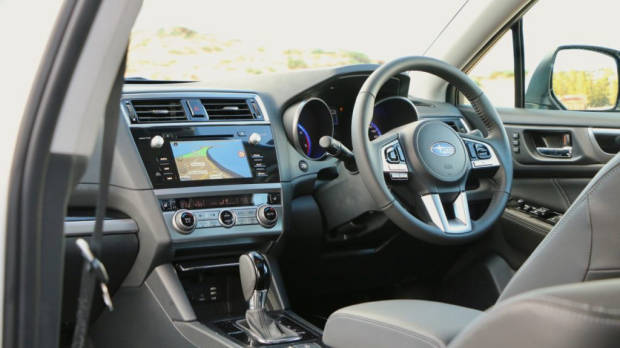
The Subaru’s aesthetic inside is airy, open, and functional. There is little clutter across the Outback’s simple dashboard, which is based around a glass-fronted touchscreen which does mark easily from fingerprints, but it has easy-access shortcuts, plus physical volume and tuning knobs – and unlike in the Volkswagen, the volume knob is closest to the driver, reflecting the Outback’s right-hand-drive origins. The screen looks smart, although its software is below par for the class. There’s no Apple CarPlay or Android Auto – these will be added in a refresh of the Outback later in 2018. The integrated navigation graphics look a bit cheesy. The steering wheel offers a large amount of shortcut buttons – perhaps a few too many – for interacting with the relatively basic digital screen ahead of the driver.
However, the Outback is a seriously comfortable vehicle, with a cabin that has been well thought-out. Even if the front seats lack the ultimate level of support found in the Volkswagen, are supple and relaxing, offering six-way electric adjustment on the Premium for both driver and passenger. The steering wheel and centre armrest are in the perfect position for cruising along comfortably. There are several huge storage areas up front, including a deep bin ahead of the shifter that includes two USB ports – one up on the Golf. However, the audio quality of the six speakers could be better.
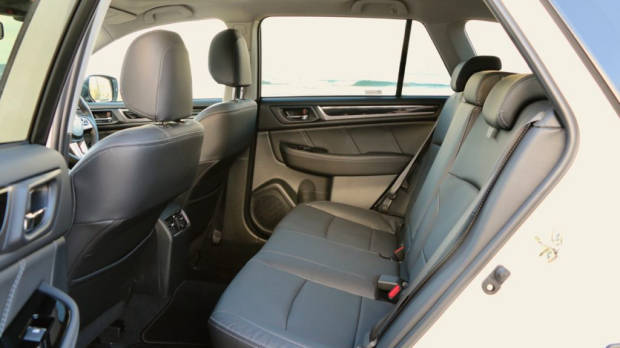
In the back, the lengthier Outback pulls ahead with substantial space for three rear seat passengers. Despite the Subaru’s more sophisticated all-wheel-drive system, there is a nearly-flat floor in the back. Along with massive legroom and headroom, this is a place where three adults can sit side by side with no problem. Air vents are standard; like the Volkswagen, there is no rear seat power for keeping devices charged up.
Winner: Golf Alltrack. Volkswagen continues to impress with lush cabins that make you feel like you’ve purchased a luxury car.
Thanks to their wagon origins, both the Subaru Outback and Volkswagen Golf Alltrack are very practical cars. Their long, low bodies provide room for larger boots than many SUVs. That said, the way boot space is measured – the volume of the boot, although only up to the window line – can be misleading. This method means that the Subaru Outback, which has a large but shallow boot below the window line (thanks to the space taken up by its handy full-size alloy spare wheel) measures in at 512 litres. Meanwhile, the Golf, which has a deep boot thanks to its space-saver spare, officially comes in at a huge 605 litres. If you stack the boots higher than the window line, the Outback has more space, though this obscures vision from the driver’s seat. The question, therefore, is whether you value a full-size spare, or not.
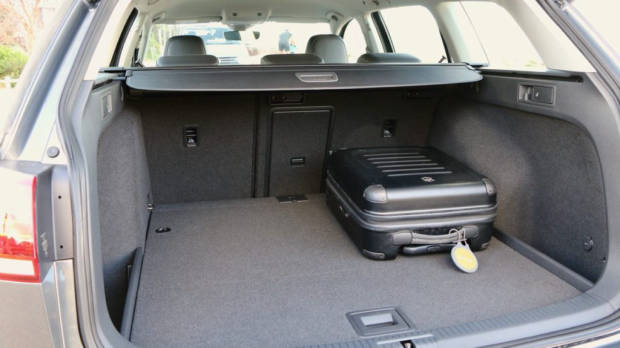
The Volkswagen Golf Alltrack’s 605-litre boot.
Aside from the available boot space on offer, the Alltrack and Outback are set apart by the features found in their cargo spaces. They both have remote releases to fold the back row of seats in a 60/40 configuration; both have two shopping bag hooks.
However, from there, they diverge. The Golf uniquely offers a large ski hatch, meaning long, narrow loads can be carried while retaining a four-passenger capacity. The Volkswagen also has a 12-volt socket in the boot, plus two useful bins either side of the boot floor for delicates. Meanwhile, the Subaru has an electric tailgate, with opening height adjustment, on the Premium – the Golf only offers a manual gate. The Outback also has space under the boot floor for its cargo cover, despite the presence of a full-size spare.
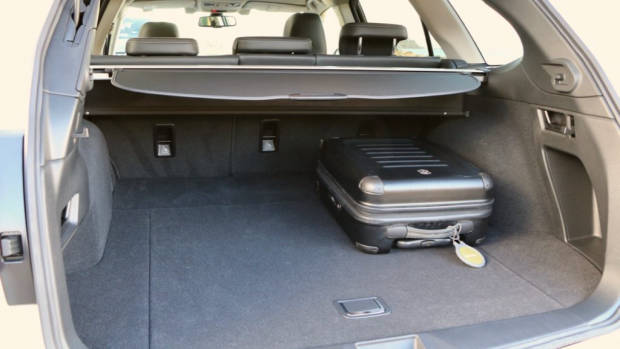
The Subaru Outback’s 512-litre boot.
With the back seats folded flat, the Outback offers a little more room than the Golf: 1,801 litres, compared to 1,620 litres. However, both are spacious enough to be able to slide a bicycle in, without removing the front wheel.
Incidental storage inside the cabin is a little more generous in the roomier Subaru. While both cars offer a fold-down armrest in the back with cupholders, the Outback has more, and larger, cubby spaces up front, including a deeper, LED-lit bin between the seats, a large shelf ahead of the shifter, and a big glove box. That said, only the Golf’s door pockets are lined throughout with felt to stop items from rattling around as they do in the Subaru’s unlined bins.
Winner: Outback. Bigger does mean better, in this case.
Subaru offers three years of capped price servicing in Australia, after which the price of servicing becomes variable. Even under the capped arrangements, though, the Outback is an expensive vehicle to service, no matter then engine. The servicing programme is also annoying, as you have to take the car in for scheduled maintenance every six months, at a minimum. The turbodiesel tested here costs $2,534 over three years. The 2.5-litre petrol is the cheapest to service, at $2,282 in three years, while the 3.6-litre six-cylinder absurdly requires seven services in three years, costing $2,711.
Volkswagen has a longer period of capped servicing on the Golf Alltrack. Five years are capped, and the servicing plan is convenient, with a year or 15,000 kilometres between visits. The 135TDI diesel tested here costs $1,374 over the first three years, while the petrol 132TSI costs $1,564 in the same period. Be aware, though, that the petrol’s fourth-year service comes in at a staggering $1,160. For the same service, the diesel costs $623.
Winner: Golf Alltrack.
What we have here are two great family cars. Each excels in their rather different missions, and depending on your tastes, one or the other will sound like the more compelling proposition.
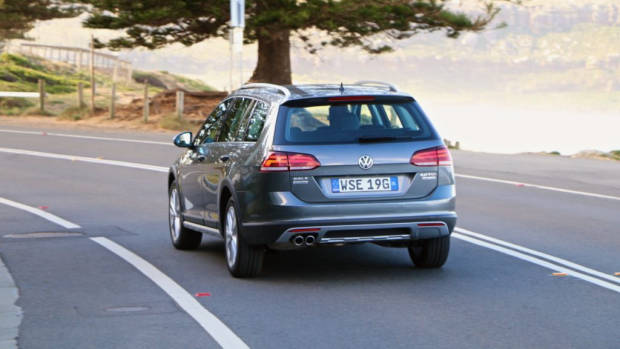
An advantage of driving a car – as opposed to an SUV – is that the simple physics of being lower to the ground means they can handle better. Family cars should be comfortable – but ideally, they should also be fun and satisfying to drive. Just because you have children doesn’t mean you should have to give up enjoying the art of driving. For that reason, we find the Volkswagen Golf Alltrack’s firmer ride quality a fair trade-off in return for its sporty, engaging handling and nimbler overall performance. Add to that the fact that the Volkswagen feels a class above in terms of interior quality and luxury, and you have a family car that makes you feel particularly satisfied.
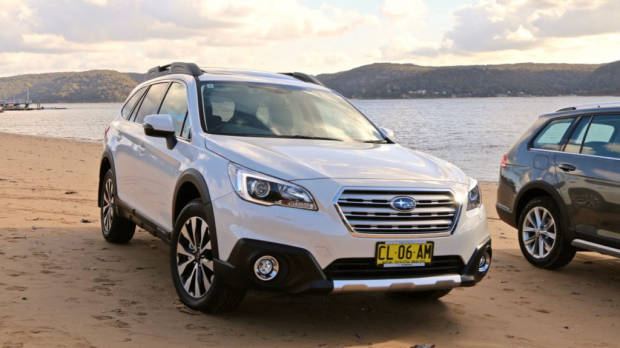
Meanwhile, the Subaru Outback makes no apologies for trading away dynamic nous in favour of ultimate driver and passenger comfort. The Outback is a supple, cosseting cruiser, with excellent ride quality, a hushed cabin, and an air of relaxation in everything that it does. When equipped with the diesel engine, it has enough get-up-and-go, as well. Add to that the fact that buying an Outback is so easy, because the Premium model has most things you’d want included with no options to navigate, and the Subaru is a great vehicle if you just want a family car that is practical, comfortable, good value and importantly, not a high-riding SUV.
For us, though, the Golf Alltrack is the more compelling proposition. The Volkswagen manages to nail most of the Outback’s practicality points, while being a smaller and easier-to-park vehicle, a car that is much more fun to drive, and an experience that is altogether more luxurious. That’s why in this alternative family car test, the Volkswagen Golf Alltrack Premium comes out on top.
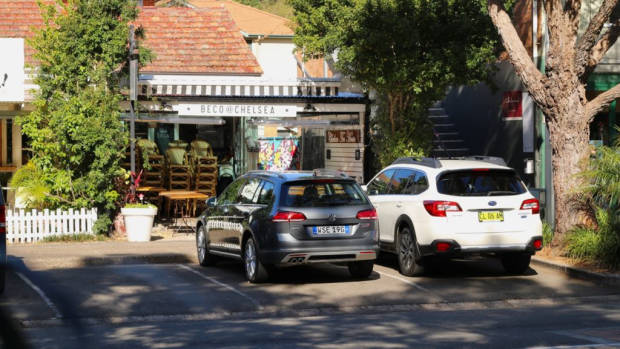
Latest comparisons
About Chasing cars
Chasing Cars reviews are 100% independent.
Because we are powered by Budget Direct Insurance, we don’t receive advertising or sales revenue from car manufacturers.
We’re truly independent – giving you Australia’s best car reviews.